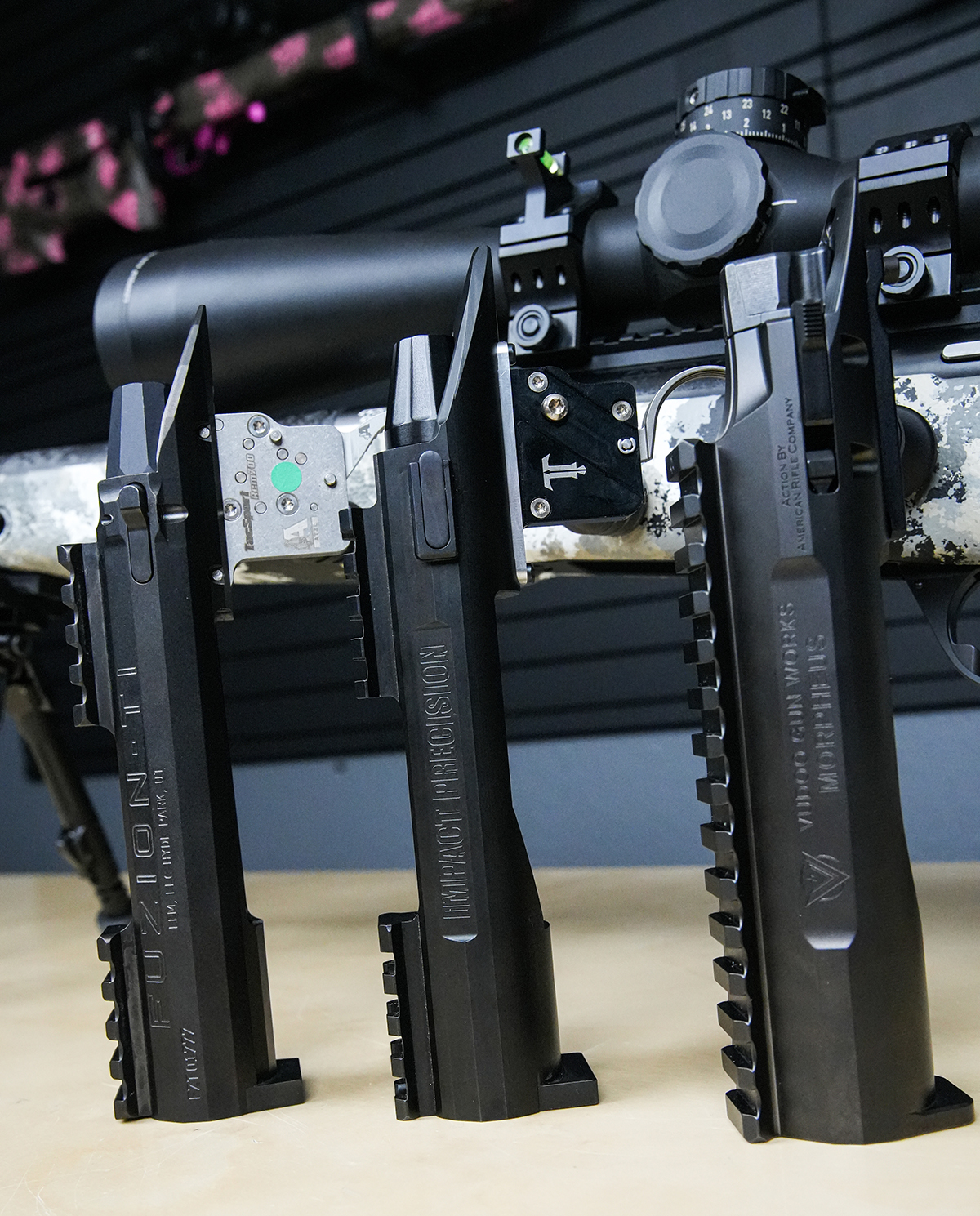At Hawkins we are fortunate to partner with a lot of companies and see numerous stocks, actions, optics, triggers, and components come through the shop in our effort to make sure everything is compatible with our products.
Because of this we often get questions about full rifle builds and custom actions from our customers. So, we figured why not cover the anatomy of a custom action and use actions we on hand to show you what some of the differences.
Here we will go over the different feature sets and terminology you might encounter while spec-ing out your action. We will also go over what action cuts and will work with which Hawkins bottom metal.
Remington 700 Clone Actions
For this article we’ll be talking about Remington 700 (REM 700) clone repeater actions. Photos for this article are of the Lone Peak Arms Fuzion Titanium, Zermatt Origin (long action), Impact Precision NBK (short action), and an American Rifle Company Coup De Grace (CDG).
We will be as thorough as possible, but if we missed your favorite action let us know and we can potentially cover it in another article or Hawkins Precision video. (Link YouTube)
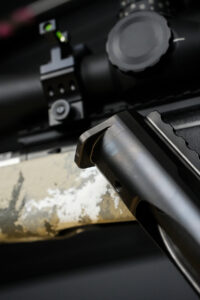 Recoil Lug – Integrated or Separate Recoil Lug
Recoil Lug – Integrated or Separate Recoil Lug
First thing up front is the recoil lug. This is what presses up to the back side of the recess in your stock, and what transfers recoil to the stock while protecting the action screws. The action body and recoil lug are also what your barrel shoulders up to.
They come either machined into the action body, or ideally pinned if they are not integral.
Generally, there are some cost differences between these options. Actions with an integral recoil lug take more machine time and thus are more expensive. Actions with a non-integral recoil lug are easier to manufacture and generally have a lower price point.
For example, the Zermatt Origin has a non-integral recoil lug that can be pinned to the action. The Impact Precision NBK’s recoil lug is machined into the action body. Standard Remington 700 actions come with non-integral recoil lugs.
Tenon Threads
Past the recoil lug, inside the action you’ll see the tenon threads. This is where the barrel mates up to the action. These days most custom actions have standardized their tenons so you can buy pre-fit barrels. Which means you can install a barrel yourself with a barrel vise and an action wrench.
This allows gunsmiths to offer high quality barrels already chambered and ready to go on actions with consistent barrel tenon dimensions. A good example is the TS Custom’s Web store where you can pick up a barrel that’s already chambered and ready to install on the action of your choice.
Pre-Fit Barrels
There are two different types of pre-fits: shouldered and barrel nut. Though in 2024 shouldered pre-fits are becoming the norm and preferred by most shooters. With a shouldered pre-fit you should be able to install a barrel without headspace gauges, but it is always good to check with a go/no-go gauge.
Barrel nut pre-fits for actions with Savage barrel tenons are also a popular choice. You will need a barrel nut, barrel nut wrench, action wrench, and headspace gauges to complete this install. Criterion Barrels has a good video on the subject – Link
Both are good options, but don’t be afraid to send an action to your gunsmith. There are no legal issues with sending an action to your gunsmith and they can be dropped in the mail without issue. Good smiths will also record the tenon dimensions on your action and be able to make more barrels for it down the road without needing the action in-hand.
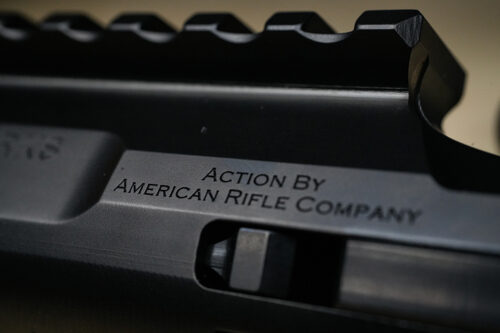 Action Bodies – Materials
Action Bodies – Materials
Action bodies there are generally made in three common material options: Stainless Steel, Titanium and Aluminum.
Stainless Steel – The majority of actions are made from stainless steel and most companies are now offering lightweight steel actions for hunters. For example Lone Peak offers a Fuzion, Fuzion Alpine Cut, and Fuzion Titanium.
Lightweight steel actions will have areas of the action cut away to make them lighter without compromising the integrity of the part. Other examples of light steel actions are the Impact NBK, Defiance AnTi, Kelbly Atlas Lite or Nanook, Stiller Wambat, and so on.
Or you can get stainless steel actions that are designed for more competition and range use that are not lightened.
Titanium – If you want to go light, maybe a Titanium action is in your future. We will cover coatings below and how to select a Titanium action with the right coatings, but when you’re counting ounces it’s hard to beat the weight savings of a Titanium action.
Companies making Titanium actions include Lone Peak Arms, Pierce Engineering, Mac Bros, Impact Precision, Zermatt Arms, Pure Precision, and Gunwerks.
Aluminum – Aluminum actions have been popular in F-Class and Benchrest for decades due to their balance of weight and rigidity. Many have steel inserts for threads and locking lugs. Some examples of Aluminum actions would be the BAT Machine Bumblebee, which is made from 7075 T6 Aluminum. Kelbly also makes many actions out of aluminum.
Action Bodies – Coatings
Receiver bodies can be DLC coated, or Nitrided, or they can come in the raw. No one at Hawkins is a material scientist, but coatings can increase the hardness of the material they are applied to and improve the corrosion and wear resistance, while making them slicker/smoother.
On the Fuzion Ti the Titanium action body is DLC coated, and the bolt bodies are nitrited. This means they don’t have a grabby feeling that raw titanium can have. Having personally run this action hunting and at NRL hunter matches for the last 3 years I can say these run great and are very smooth.
The Origin has a DLC coated bolt head and a Nitrited receiver and bolt body. Which also runs very smoothly.
In general, if you want a smooth-running action, DLC coating or nitride is preferred. If you’re looking for a raw material look you may sacrifice smoother operation for esthetics. The smoothest running actions are generally DLC coated stainless steel.
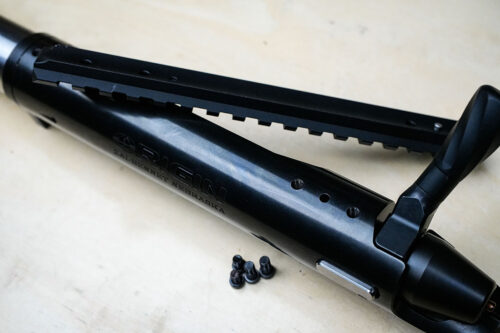 Picatinny Rails – Integral or Screw/Pinned
Picatinny Rails – Integral or Screw/Pinned
Up top, most actions either have the picatinny rail machined into the action or they have mounting points to screw (and sometimes pin) a pic rail on the action. These mounting points is where you could also mount scope rings directly to the receiver.
The machined in pic rails obviously can’t come loose, but screwing and pinning rings directly to your action does offer a weight savings.
With almost all custom actions and high-quality scope rings you should not have to worry about lapping scope rings and alignment issues. That means you can install a set of Long-Range Hybrids or Featherweight rings directly to your action, save some weight, and be all set.
That said, if you want the truest alignment and are not worried about weight, a 1-pc mount on a fully machined, integral rail is the best option.
Action Cuts for Bottom Metal – BDL
On the bottom of the action there’s a few ways they can be set-up. This is where pairing your bottom metal to the internal box or magazine cut is important.
If you’re wanting to run a BDL, your action will need to have feed lips machined into the action body. If your action has feed lips, ideally it will be cut to accommodate a Wyatt’s Extended Internal box. These will allow you to maximize cartridge overall length as internal boxes from Wyatt’s outdoors are longer than a standard Remington 700 style internal box.
Wyatt’s has two options for internal boxes, an MBE which is a stagger feed box and a CFE, which is center feed. Side note, CFE boxes also do not require feed lips but can be used in actions with feed lips.
For bottom metal, the M5 Oberndorf is cut to take Wyatt Extended boxes already, while the standard Oberndorf is set up to take standard length boxes. Though they can be modified by your gunsmith to take extended boxes if you’d like.
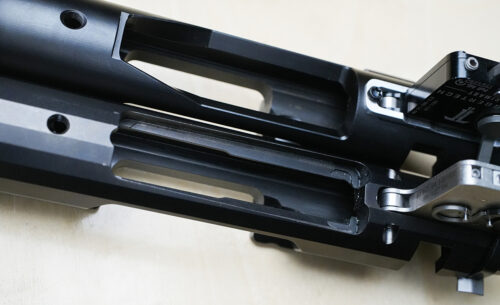 Action Cuts for Bottom Metal – Magazines
Action Cuts for Bottom Metal – Magazines
If your action is not cut with feed lips like an Impact 737R, then they are set up to run magazines such as a Hunter flush magazine or an AICS pattern magazine. You will likely also see on the spec sheet if the action is cut to accept an AW magazine, which is a true double stack style 10 round short action magazine we see most at PRS matches.
However, if your action accepts AICS magazines that’s normally the easy route. An AW cut action just gives you more options.
In the long action length, actions cut for CIP length magazines will allow you the most Cartridge Overall Length for loading heavy for caliber bullets long. CIP (3.850) length magazines are the longest AICS pattern magazines available as of the publishing of this article. If they are not, it is likely they are set-up to take 3.715’ length magazines.
Also, if your action has feed lips you can also still use AICS pattern magazines. The cartridges will just present between the feedlips, but the magazine will not utilize them to retain anything.
Good options on bottom metal for those are our Hawkins M5 DBM and our Hunter DBM.
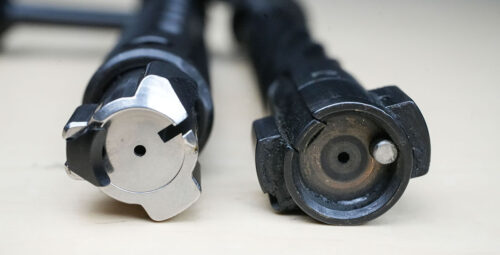 Bolt Bodies
Bolt Bodies
There are generally two types of bolts you’ll find on actions: 2-lug action or a 3-lug. Two-lug actions are a 90-degree bolt throw and generally have a lighter feeling bolt lift. The 3 lugs are normally a shorter bolt throw, but with a trade off with more needing more umpfff to lift the bolt.
Bolt bodies can come in fully machined, single bolt units or have floating or swappable bolt heads. For example, the Lone Peak Arms bolts are a fully machined bolt body. If you were looking to run a barrel switch set-up on a single piece bolt action you would swap the bolt with the correct bolt face bolt and change barrels.
Swappable bolt heads is another option for making a switch barrel set-up. Good examples of these are American Rifle Company (ARC) and Zermatt actions. Swappable bolt heads allow you to have one bolt, but swap bolt heads if you want go to from a standard .473 bolt face to say a magnum, and so on.
Ejection/Extraction
In most cases, actions will feature either a M16 extractor or controlled round feed. The M16 extractor is a popular upgrade for factory Remington 700s as the design is strong, reliable and easy to replace as needed. These generally come on push feed style actions where the extractor snaps over the case rim while it enters the chamber when you close the bolt.
On controlled round feed actions, the rim of the cartridge slides under the extractor when the bolt pushes the cartridge forward. Meaning if you withdraw the round before it completely enters the chamber it will be held in place by the extractor/bolt.
For ejection of cases, you can either get a plunger ejector that is spring loaded and continually presses against the back of the case from when the round chambers until it bolt slides far enough to the case to eject from the action body.
Mechanical ejectors use a hard stop that hits the base of your case when you run your bolt back and ejects the case.
Plunger ejectors tend to leave a pile of brass in one spot but will need to be replaced very heavy use (like really heavy use) while mechanical ejectors generally won’t fail but fling brass as hard as you run the bolt.
Bolt Knobs
The last decision you may make on your custom action are bolt knobs. Actions can come with smaller/lighter bolt knobs for hunting rifles. You may want a large bolt knob for a competition rifle.
Zermatt offers numerous bolt knob options to allow you to customize your action to your rifle. We’ll include some examples of what you can choose from here.
Conclusion
And that’s the anatomy of an action on a high level. Hopefully seeing these action features help you with your action purchase. It’s a great time to be into precision rifles as there’s a lot of good options out there!

